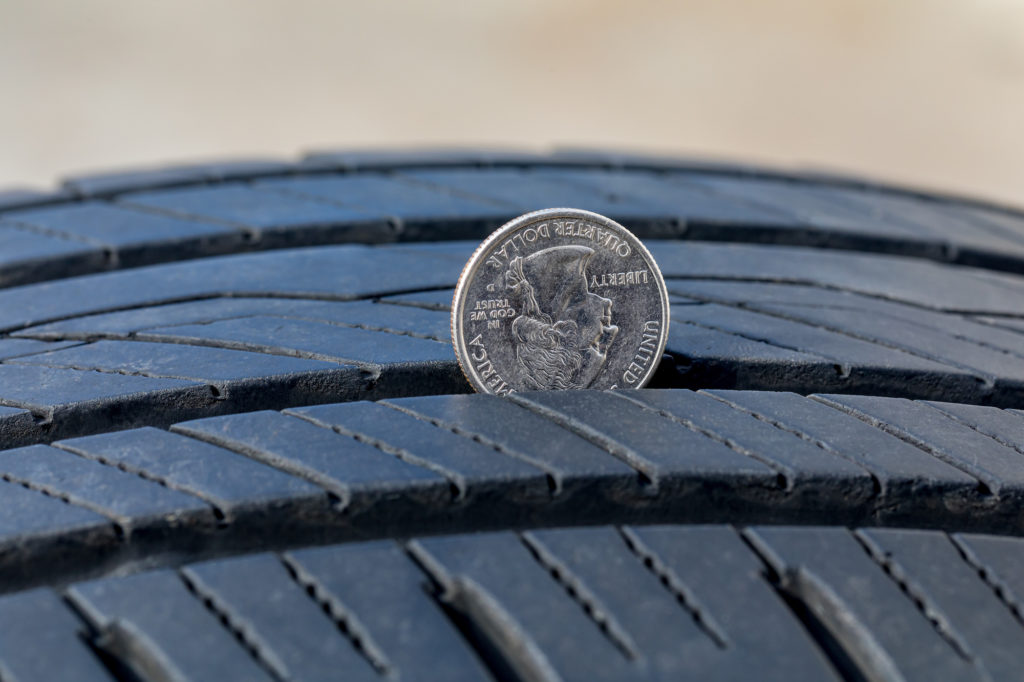It’s easy to neglect what seems like the most basic part of your vehicle, your tires. But in reality they contribute significantly to the well being of your vehicle and even more, the safety of occupants. Tires impact braking and vehicle handling which is why proper maintenance is paramount. It may seem daunting at first between rotation, pressure, and treads and figuring out what needs to be done when.
Tire Tread
Checking tire tread is easy and there’s a simple trick to do so. Technically, tires should have at least 4/32” of tread depth for safe operation. Otherwise you may face the inability to maintain road traction and at worse a blown tire. Before you get to a dangerous situation it’s time to replace those tires. To measure, use a tread depth gauge if you have one or pick one up, they’re widely available at automotive or parts stores or simply use the quarter trick with a US quarter.
Another easy coin test is the quarter test. Insert a quarter into your tread groove. If the tread touches Washington’s head, you have at least 4/32 inch of tread remaining. If the tread doesn’t touch his head, it’s time to look at replacing your tires.

Tire Pressure
Tire pressure is a simple way to extend the life of your tires and also maintain good gas mileage. As is with tread this should be checked once a month and can be done in minutes.
For this maintenance check an inexpensive tool is required. Tire pressure gauges can be found in any automotive or parts store and don’t cost much. While a visual check is important the accurate measurement is a much better indicator.
Take a look on the label on the inside of the drivers side door or the owner’s manual to determine the recommended air pressure for your specific vehicle. The number will be labeled in ‘psi’ (pounds per square inch).
Unscrew the valve cap and place the gauge over top of the valve stem, press down with enough pressure to ensure a good seal. Read the numbers that line up with the bottom of the gauge. Repeat this process with all four tires. If air needs to be added use an air compressor, if you don’t have one, they’re available at all gas stations. Continue to use the gauge until the correct pressure is reached.
Maintenance: stuff for the experts
If you’re beginning to feel confident in the realm of tire maintenance, that’s great, but certain things should remain for the experts to take care of. Even routine tire maintenance requires technical knowledge and tools that you may not have. However, understanding what maintenance needs to be done should help you feel more comfortable next time you go to the shop. Tire rotation, balancing, and alignments are commonly used terms that we’ve broken down, so you know what you’re getting and why.
Tire Rotation
Tires should be rotated between 5000-8000 miles. The wide gap takes into consideration what the vehicle manufacturer recommends.
The most common reason you’ll hear it’s important to rotate tires is to evenly disperse wear on each tire. It may seem like they would evenly distribute but each corner of your vehicle operates differently requiring each tire to work a little differently. For example, a front-wheel drive vehicle requires the front two tires to take on a greater proportion of the load working to move the car and break.
Expanding on the even wear practice, this will also keep tread depth uniform across all tires providing even traction meaning a safer overall vehicle.
Tire Balancing
Tires have small metal attachments that are clamped around the rim. These are placed in specific locations to rid of any imperfections in distribution of the tires weight. If you can feel vibration when driving the vehicle especially greater than 55 mph this is an indication that the tires need to be balanced. It’s inexpensive and can be done quickly. Whenever the tire is removed from the wheel it should also be balanced. During an inspection if any of the three metal pieces are missing, it’s essential to bring your vehicle in for a tire balancing.
Wheel Alignment
A wheel alignment, or tire alignment helps tire performance and can improve longevity. It is an adjustment to the suspension which is the connection between the vehicle and the wheels. There are a few telltale signs to determine if you’re in need of an alignment: uneven tread wear, vehicle pulling to the left or right, steering wheel not centered while driving straight, and steering wheel vibration.
Any time new tires are installed or you feel any of the above mentioned symptoms you should have a wheel alignment performed.




Comments are closed